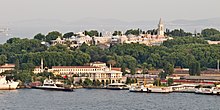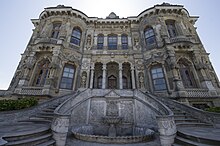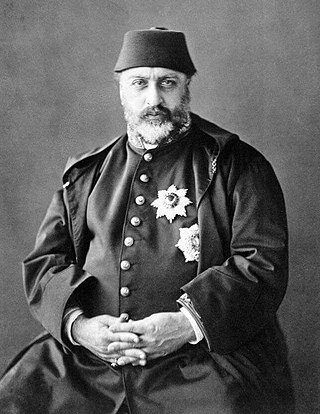
Abdulaziz was the sultan of the Ottoman Empire from 25 June 1861 to 30 May 1876, when he was overthrown in a government coup. He was a son of Sultan Mahmud II and succeeded his brother Abdulmejid I in 1861.
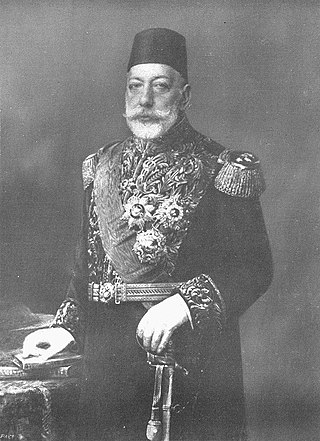
Mehmed V Reşâd was the penultimate sultan of the Ottoman Empire from 1909 to 1918. Mehmed V reigned as a constitutional monarch, interfering little when it came to government affairs, though the constitution was held with little regard by his ministries. The first half of his reign was marked by contentious politicking between factions of the Young Turks, and the second half by war and domination of the Committee of Union and Progress and the Three Pashas.

The Topkapı Palace, or the Seraglio, is a large museum and library in the east of the Fatih district of Istanbul in Turkey. From the 1460s to the completion of Dolmabahçe Palace in 1856, it served as the administrative center of the Ottoman Empire, and was the main residence of its sultans.

Dolmabahçe Palace located in the Beşiktaş district of Istanbul, Turkey, on the European coast of the Bosporus strait, served as the main administrative center of the Ottoman Empire from 1856 to 1887 and from 1909 to 1922.
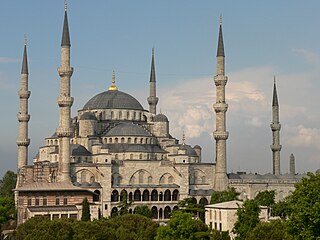
Ottoman architecture is an architectural style or tradition that developed under the Ottoman Empire over a long period, undergoing some significant changes during its history. It first emerged in northwestern Anatolia in the late 13th century and developed from earlier Seljuk Turkish architecture, with influences from Byzantine and Iranian architecture along with other architectural traditions in the Middle East. Early Ottoman architecture experimented with multiple building types over the course of the 13th to 15th centuries, progressively evolving into the classical Ottoman style of the 16th and 17th centuries. This style was a mixture of native Turkish tradition and influences from the Hagia Sophia, resulting in monumental mosque buildings focused around a high central dome with a varying number of semi-domes. The most important architect of the classical period is Mimar Sinan, whose major works include the Şehzade Mosque, Süleymaniye Mosque, and Selimiye Mosque. The second half of the 16th century also saw the apogee of certain decorative arts, most notably in the use of Iznik tiles.

The Balyan family was a prominent Armenian family in the Ottoman Empire of court architects in the service of Ottoman sultans and other members of the Ottoman dynasty during the 18th and 19th centuries. For five generations, they designed and constructed numerous major buildings in the Ottoman Empire, including palaces, mansions, konaks, kiosks, yalis, mosques, churches, and various public buildings, mostly in Constantinople.

The Islamic Sacred Relics, also known as the Holy Relics, known collectively as the Sacred Trust, consist of religious relics sent to the Ottoman Sultans between the 16th century to the late 19th century.
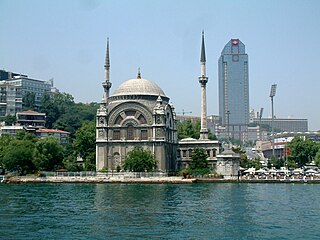
Bezmiâlem Sultan, called also Bazimialam Sultan, was a consort of Sultan Mahmud II, and Valide sultan to their son, Sultan Abdulmejid I of the Ottoman Empire.
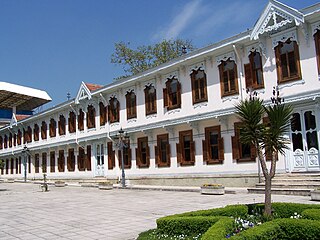
Yıldız Palace is a vast complex of former imperial Ottoman pavilions and villas in Beşiktaş, Istanbul, Turkey, built in the 19th and early 20th centuries. It was used as a residence by the sultan and his court in the late 19th century.
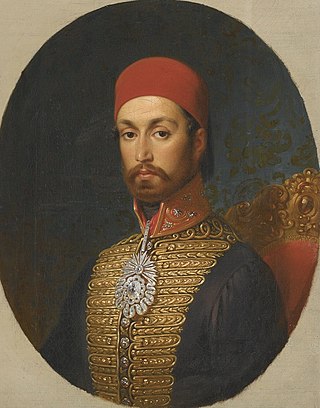
Abdulmejid I was the sultan of the Ottoman Empire. He succeeded his father Mahmud II on 2 July 1839. His reign was notable for the rise of nationalist movements within the empire's territories. Abdulmejid wanted to encourage Ottomanism among secessionist subject nations and stop rising nationalist movements within the empire, but despite new laws and reforms to integrate non-Muslims and non-Turks more thoroughly into Ottoman society, his efforts failed in this regard. Abdulmejid's biggest achievement was the announcement and application of the Tanzimat (reorganization) reforms which were prepared by his father and effectively started the modernization of the Ottoman Empire in 1839.

The following outline is provided as an overview of and topical guide to the Ottoman Empire:
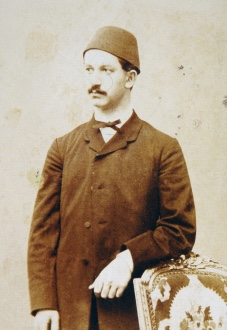
Şehzade Ahmed Kemaleddin Efendi was an Ottoman prince, son of Sultan Abdulmejid I and his consort Verdicenan Kadın.

The following outline is provided as an overview of and topical guide to Istanbul:
In Turkey, the Directorate of National Palaces is an institution responsible for protecting national palaces across the country. It is affiliated with the office of the President of Turkey.
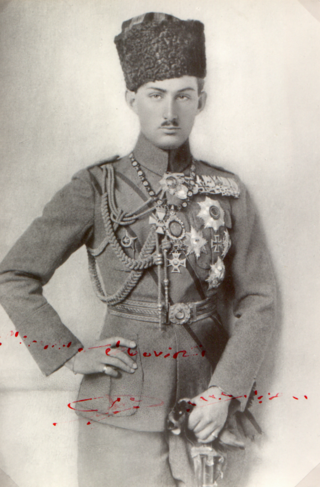
Şehzade Ömer Faruk Efendi was an Ottoman prince, the son of the last caliph of Muslim world Abdulmejid II and his first consort Şehsuvar Hanım. He was also the son-in-law of Sultan Mehmed VI of the Ottoman Empire because he married his younger daughter Rukiye Sabiha Sultan.
Şehzade Mehmed Şevket Efendi was an Ottoman prince, the son of Sultan Abdulaziz and Neşerek Kadın.

Ottoman Baroque architecture, also known as Turkish Baroque, was a period in Ottoman architecture in the 18th century and early 19th century which was influenced by European Baroque architecture. Preceded by the changes of the Tulip Period and Tulip Period architecture, the style marked a significant departure from the classical style of Ottoman architecture and introduced new decorative forms to mostly traditional Ottoman building types. It emerged in the 1740s during the reign of Mahmud I (1730–1754) and its most important early monument was the Nuruosmaniye Mosque, completed in 1755. Later in the 18th century, new building types were also introduced based on European influences. The last fully Baroque monuments, such as the Nusretiye Mosque, were built by Mahmud II in the early 19th century, but during this period new European-influenced styles were introduced and supplanted the Baroque.

Şehzade Mehmed Burhaneddin Efendi was an Ottoman prince, the son of Sultan Abdulmejid I and one of his consorts, Nükhetsezâ Hanım.
